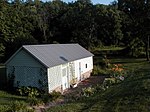Johnsontown, Berkeley County, West Virginia
Eastern Panhandle geography stubsUnincorporated communities in Berkeley County, West VirginiaUnincorporated communities in West VirginiaUse mdy dates from July 2023

Johnsontown is an unincorporated community at the junction of West Virginia Route 9 and Camp Frame Road along Tilhance Creek in Berkeley County, West Virginia, United States. The town was originally named Soho by settlers after Soho in London's West End. Its name was later changed to Johnstontown and finally Johnsontown.
Excerpt from the Wikipedia article Johnsontown, Berkeley County, West Virginia (License: CC BY-SA 3.0, Authors, Images).Johnsontown, Berkeley County, West Virginia
Hedgesville Road,
Geographical coordinates (GPS) Address Nearby Places Show on map
Geographical coordinates (GPS)
| Latitude | Longitude |
|---|---|
| N 39.578333333333 ° | E -78.039444444444 ° |
Address
Hedgesville Road 8899
25427
West Virginia, United States
Open on Google Maps







